Unit 32 Business Strategy Report: Strategic Analysis of Nike Company
VerifiedAdded on 2021/10/06
|21
|6141
|232
Report
AI Summary
This report provides a comprehensive analysis of Nike's business strategy, encompassing its strategic position, strategic choices, and evaluation. The report begins with a SWOT analysis to identify Nike's strengths, weaknesses, opportunities, and threats. It then delves into strategic choices, including vertical integration, product development, cost leadership, differentiation, and strategic methods. The report further evaluates the proposed strategies using SAFe criteria and Quantitative Strategic Planning Matrix (QSPM) to assess their effectiveness and identify areas for improvement. The analysis also considers the strengths and weaknesses of the strategies in the Vietnamese market, concluding with a summary of key findings and recommendations. The report utilizes concepts from Johnson et al. (2017) to support its arguments and provide a robust framework for understanding Nike's strategic approach.
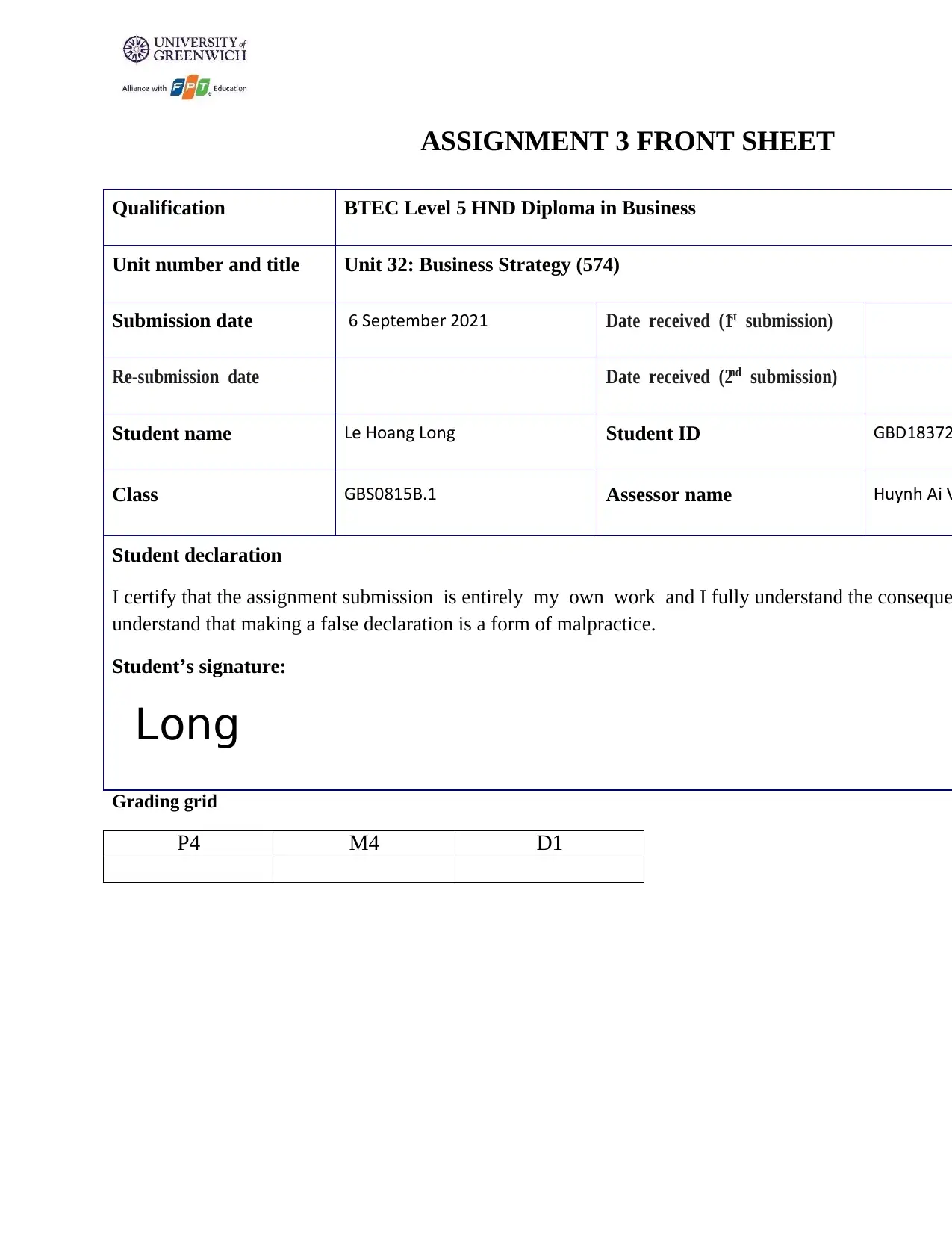
ASSIGNMENT 3 FRONT SHEET
Qualification BTEC Level 5 HND Diploma in Business
Unit number and title Unit 32: Business Strategy (574)
Submission date 6 September 2021 Date received (1st submission)
Re-submission date Date received (2nd submission)
Student name Le Hoang Long Student ID GBD18372
Class GBS0815B.1 Assessor name Huynh Ai V
Student declaration
I certify that the assignment submission is entirely my own work and I fully understand the conseque
understand that making a false declaration is a form of malpractice.
Student’s signature:
Long
Grading grid
P4 M4 D1
Qualification BTEC Level 5 HND Diploma in Business
Unit number and title Unit 32: Business Strategy (574)
Submission date 6 September 2021 Date received (1st submission)
Re-submission date Date received (2nd submission)
Student name Le Hoang Long Student ID GBD18372
Class GBS0815B.1 Assessor name Huynh Ai V
Student declaration
I certify that the assignment submission is entirely my own work and I fully understand the conseque
understand that making a false declaration is a form of malpractice.
Student’s signature:
Long
Grading grid
P4 M4 D1
Paraphrase This Document
Need a fresh take? Get an instant paraphrase of this document with our AI Paraphraser
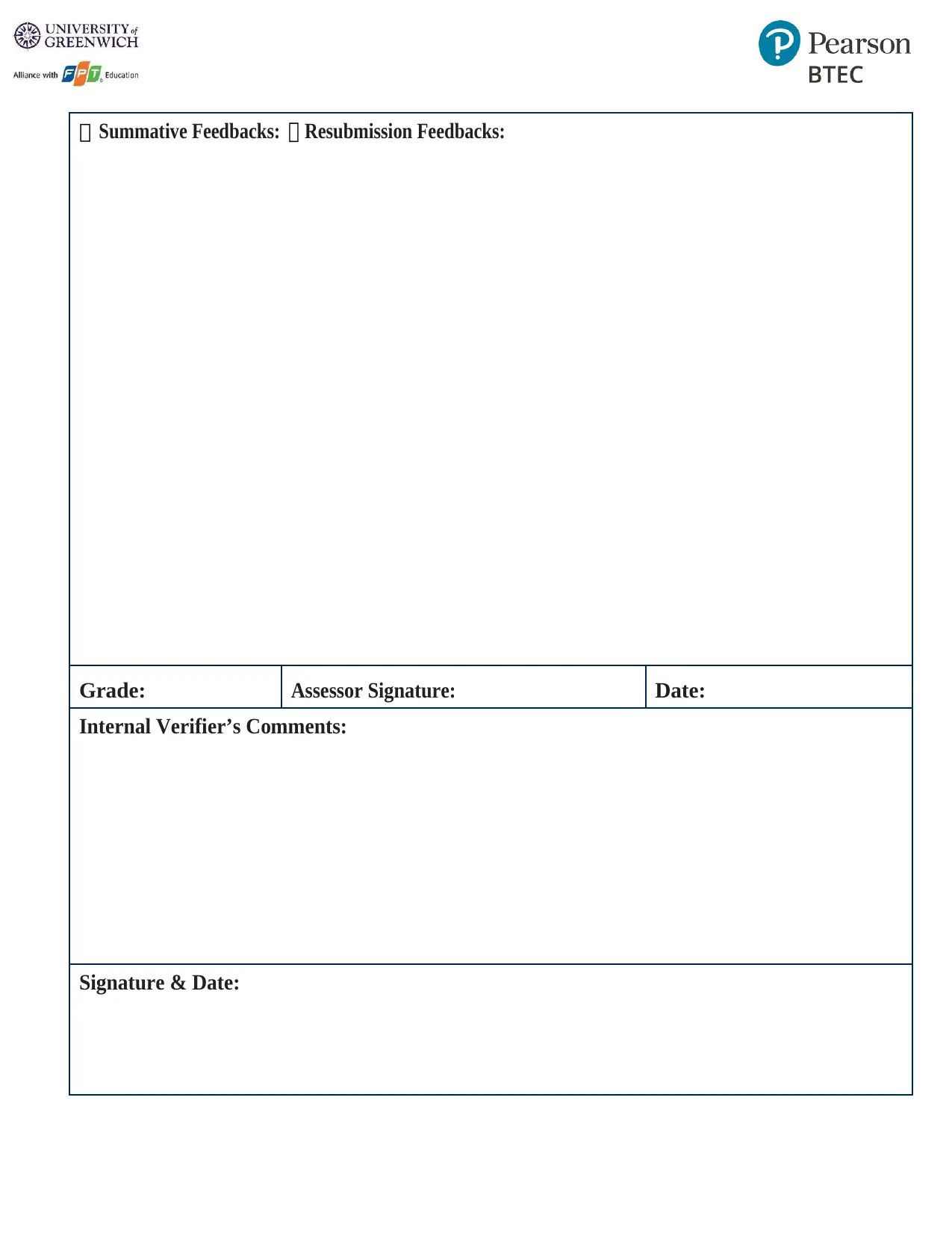
Summative Feedbacks: Resubmission Feedbacks:
Grade: Assessor Signature: Date:
Internal Verifier’s Comments:
Signature & Date:
Grade: Assessor Signature: Date:
Internal Verifier’s Comments:
Signature & Date:
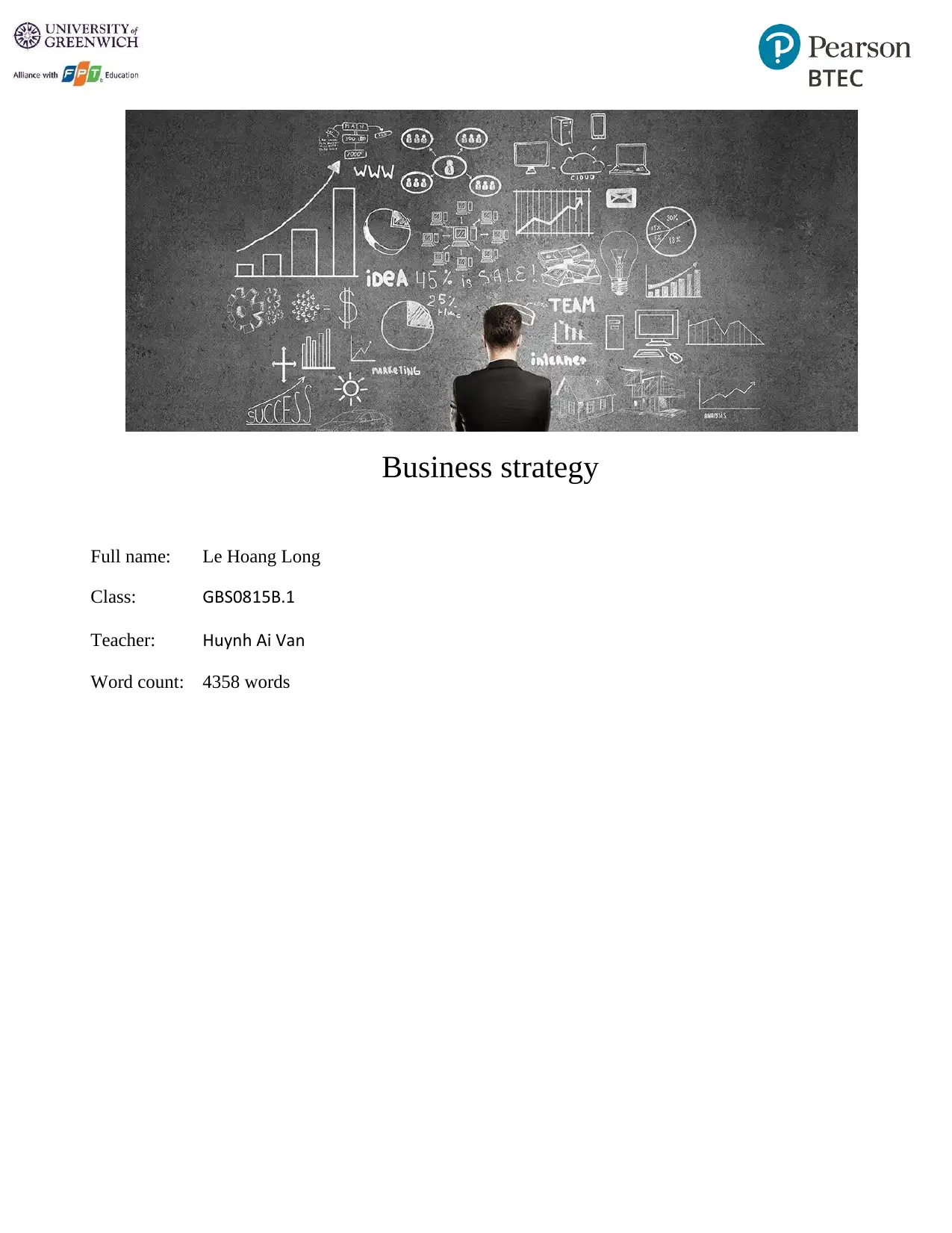
Business strategy
Full name: Le Hoang Long
Class: GBS0815B.1
Teacher: Huynh Ai Van
Word count: 4358 words
Full name: Le Hoang Long
Class: GBS0815B.1
Teacher: Huynh Ai Van
Word count: 4358 words
⊘ This is a preview!⊘
Do you want full access?
Subscribe today to unlock all pages.

Trusted by 1+ million students worldwide
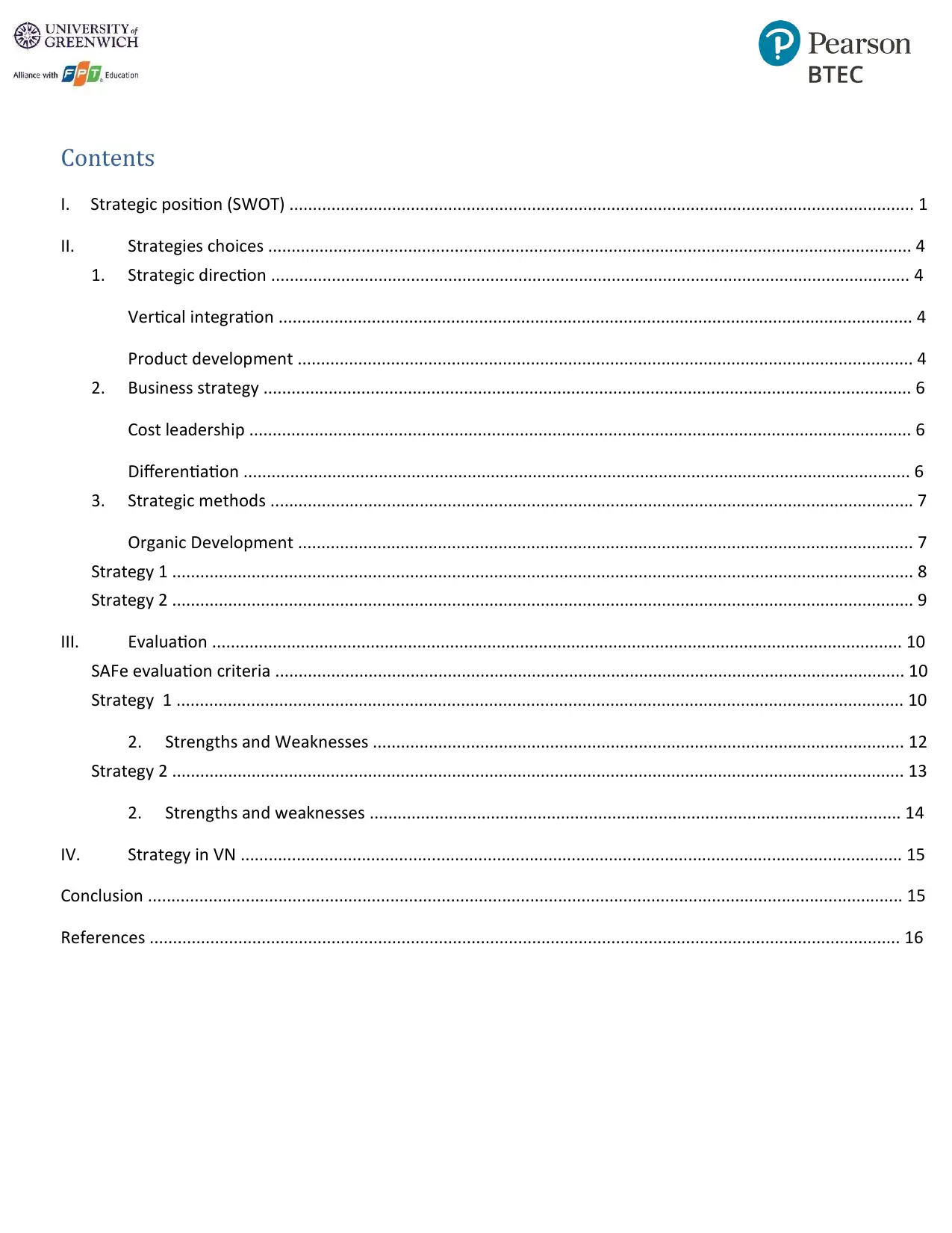
Contents
I. Strategic position (SWOT) ...................................................................................................................................... 1
II. Strategies choices .......................................................................................................................................... 4
1. Strategic direction ......................................................................................................................................... 4
Vertical integration ........................................................................................................................................ 4
Product development .................................................................................................................................... 4
2. Business strategy ........................................................................................................................................... 6
Cost leadership .............................................................................................................................................. 6
Differentiation ............................................................................................................................................... 6
3. Strategic methods .......................................................................................................................................... 7
Organic Development .................................................................................................................................... 7
Strategy 1 ............................................................................................................................................................... 8
Strategy 2 ............................................................................................................................................................... 9
III. Evaluation .................................................................................................................................................... 10
SAFe evaluation criteria ....................................................................................................................................... 10
Strategy 1 ............................................................................................................................................................ 10
2. Strengths and Weaknesses .................................................................................................................. 12
Strategy 2 ............................................................................................................................................................. 13
2. Strengths and weaknesses .................................................................................................................. 14
IV. Strategy in VN .............................................................................................................................................. 15
Conclusion .................................................................................................................................................................. 15
References ................................................................................................................................................................. 16
I. Strategic position (SWOT) ...................................................................................................................................... 1
II. Strategies choices .......................................................................................................................................... 4
1. Strategic direction ......................................................................................................................................... 4
Vertical integration ........................................................................................................................................ 4
Product development .................................................................................................................................... 4
2. Business strategy ........................................................................................................................................... 6
Cost leadership .............................................................................................................................................. 6
Differentiation ............................................................................................................................................... 6
3. Strategic methods .......................................................................................................................................... 7
Organic Development .................................................................................................................................... 7
Strategy 1 ............................................................................................................................................................... 8
Strategy 2 ............................................................................................................................................................... 9
III. Evaluation .................................................................................................................................................... 10
SAFe evaluation criteria ....................................................................................................................................... 10
Strategy 1 ............................................................................................................................................................ 10
2. Strengths and Weaknesses .................................................................................................................. 12
Strategy 2 ............................................................................................................................................................. 13
2. Strengths and weaknesses .................................................................................................................. 14
IV. Strategy in VN .............................................................................................................................................. 15
Conclusion .................................................................................................................................................................. 15
References ................................................................................................................................................................. 16
Paraphrase This Document
Need a fresh take? Get an instant paraphrase of this document with our AI Paraphraser
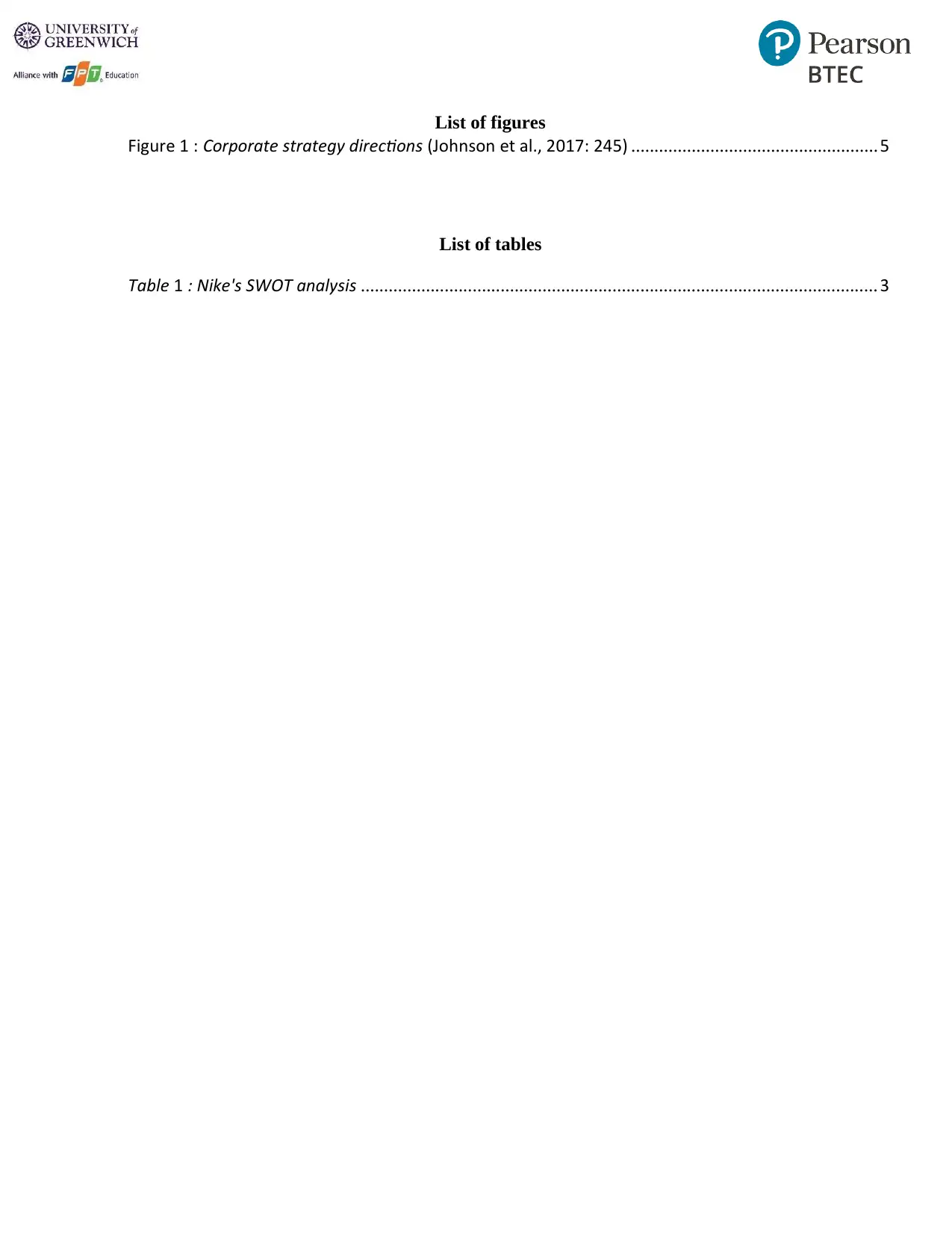
List of figures
Figure 1 : Corporate strategy directions (Johnson et al., 2017: 245) ..................................................... 5
List of tables
Table 1 : Nike's SWOT analysis ............................................................................................................... 3
Figure 1 : Corporate strategy directions (Johnson et al., 2017: 245) ..................................................... 5
List of tables
Table 1 : Nike's SWOT analysis ............................................................................................................... 3
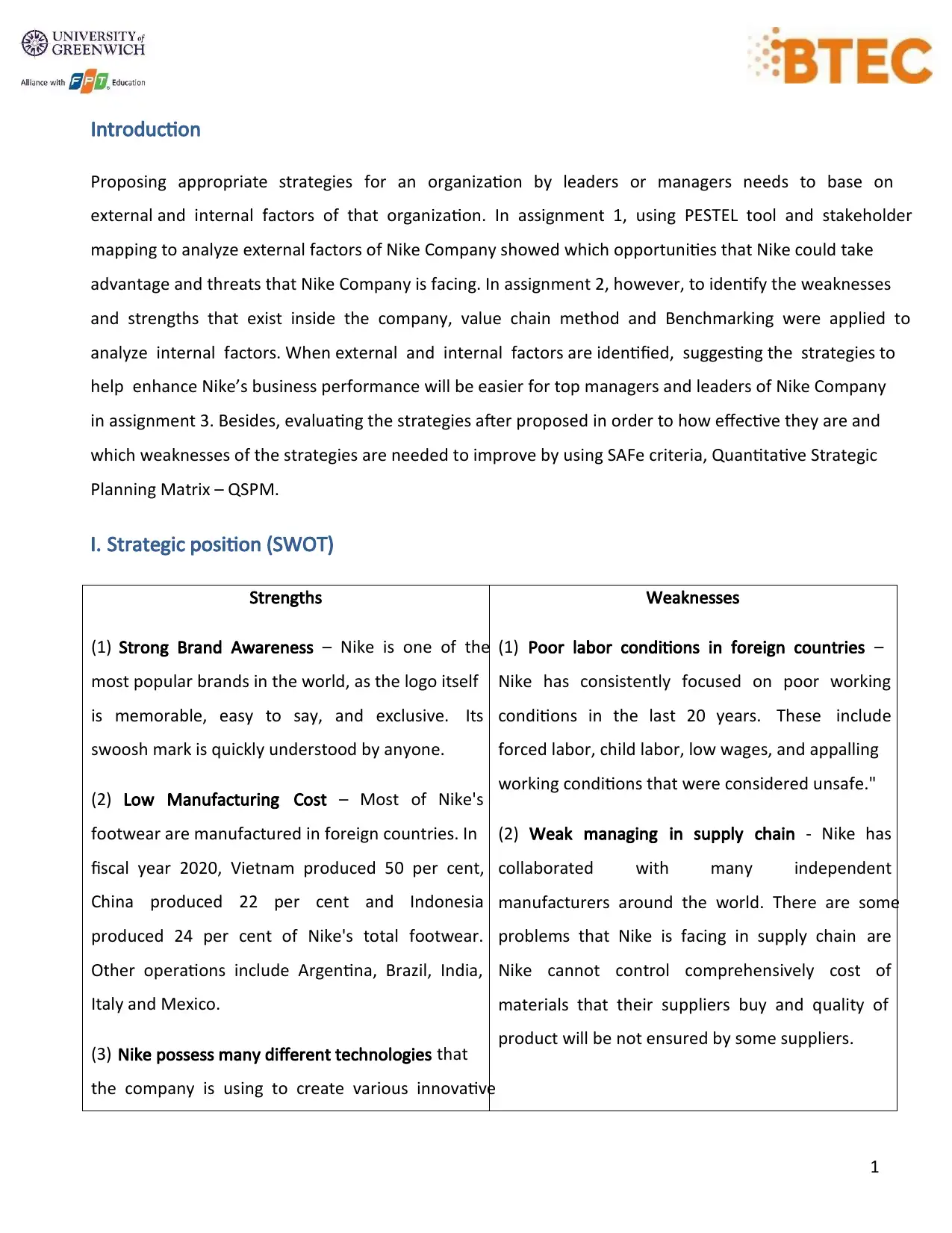
1
Introduction
Proposing appropriate strategies for an organization by leaders or managers needs to base on
external and internal factors of that organization. In assignment 1, using PESTEL tool and stakeholder
mapping to analyze external factors of Nike Company showed which opportunities that Nike could take
advantage and threats that Nike Company is facing. In assignment 2, however, to identify the weaknesses
and strengths that exist inside the company, value chain method and Benchmarking were applied to
analyze internal factors. When external and internal factors are identified, suggesting the strategies to
help enhance Nike’s business performance will be easier for top managers and leaders of Nike Company
in assignment 3. Besides, evaluating the strategies after proposed in order to how effective they are and
which weaknesses of the strategies are needed to improve by using SAFe criteria, Quantitative Strategic
Planning Matrix – QSPM.
I. Strategic position (SWOT)
Strengths Weaknesses
(1) Strong Brand Awareness – Nike is one of the
most popular brands in the world, as the logo itself
is memorable, easy to say, and exclusive. Its
swoosh mark is quickly understood by anyone.
(2) Low Manufacturing Cost – Most of Nike's
footwear are manufactured in foreign countries. In
fiscal year 2020, Vietnam produced 50 per cent,
China produced 22 per cent and Indonesia
produced 24 per cent of Nike's total footwear.
Other operations include Argentina, Brazil, India,
Italy and Mexico.
(3) Nike possess many different technologies that
the company is using to create various innovative
(1) Poor labor conditions in foreign countries –
Nike has consistently focused on poor working
conditions in the last 20 years. These include
forced labor, child labor, low wages, and appalling
working conditions that were considered unsafe."
(2) Weak managing in supply chain - Nike has
collaborated with many independent
manufacturers around the world. There are some
problems that Nike is facing in supply chain are
Nike cannot control comprehensively cost of
materials that their suppliers buy and quality of
product will be not ensured by some suppliers.
Introduction
Proposing appropriate strategies for an organization by leaders or managers needs to base on
external and internal factors of that organization. In assignment 1, using PESTEL tool and stakeholder
mapping to analyze external factors of Nike Company showed which opportunities that Nike could take
advantage and threats that Nike Company is facing. In assignment 2, however, to identify the weaknesses
and strengths that exist inside the company, value chain method and Benchmarking were applied to
analyze internal factors. When external and internal factors are identified, suggesting the strategies to
help enhance Nike’s business performance will be easier for top managers and leaders of Nike Company
in assignment 3. Besides, evaluating the strategies after proposed in order to how effective they are and
which weaknesses of the strategies are needed to improve by using SAFe criteria, Quantitative Strategic
Planning Matrix – QSPM.
I. Strategic position (SWOT)
Strengths Weaknesses
(1) Strong Brand Awareness – Nike is one of the
most popular brands in the world, as the logo itself
is memorable, easy to say, and exclusive. Its
swoosh mark is quickly understood by anyone.
(2) Low Manufacturing Cost – Most of Nike's
footwear are manufactured in foreign countries. In
fiscal year 2020, Vietnam produced 50 per cent,
China produced 22 per cent and Indonesia
produced 24 per cent of Nike's total footwear.
Other operations include Argentina, Brazil, India,
Italy and Mexico.
(3) Nike possess many different technologies that
the company is using to create various innovative
(1) Poor labor conditions in foreign countries –
Nike has consistently focused on poor working
conditions in the last 20 years. These include
forced labor, child labor, low wages, and appalling
working conditions that were considered unsafe."
(2) Weak managing in supply chain - Nike has
collaborated with many independent
manufacturers around the world. There are some
problems that Nike is facing in supply chain are
Nike cannot control comprehensively cost of
materials that their suppliers buy and quality of
product will be not ensured by some suppliers.
⊘ This is a preview!⊘
Do you want full access?
Subscribe today to unlock all pages.

Trusted by 1+ million students worldwide
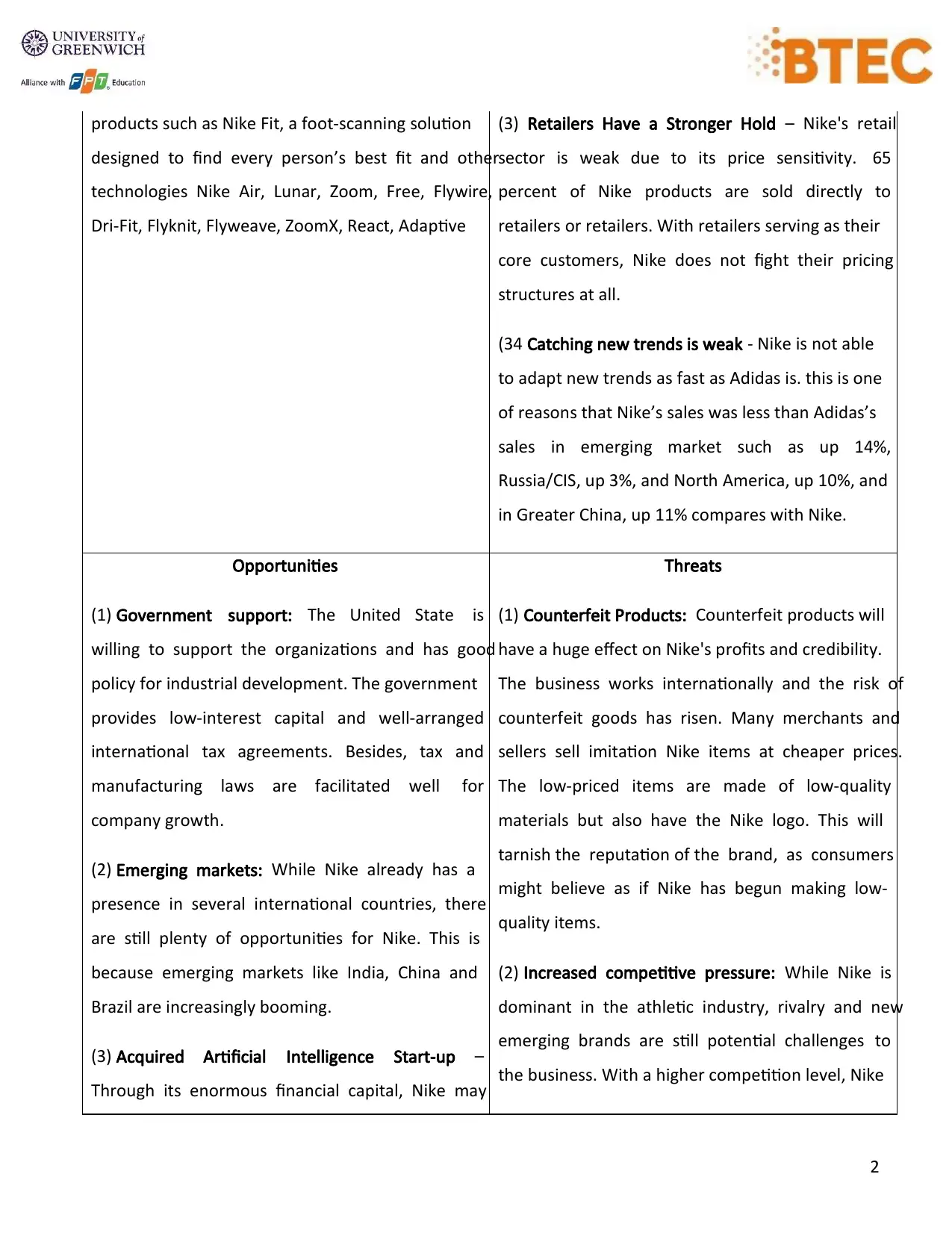
2
products such as Nike Fit, a foot-scanning solution
designed to find every person’s best fit and other
technologies Nike Air, Lunar, Zoom, Free, Flywire,
Dri-Fit, Flyknit, Flyweave, ZoomX, React, Adaptive
(3) Retailers Have a Stronger Hold – Nike's retail
sector is weak due to its price sensitivity. 65
percent of Nike products are sold directly to
retailers or retailers. With retailers serving as their
core customers, Nike does not fight their pricing
structures at all.
(34 Catching new trends is weak - Nike is not able
to adapt new trends as fast as Adidas is. this is one
of reasons that Nike’s sales was less than Adidas’s
sales in emerging market such as up 14%,
Russia/CIS, up 3%, and North America, up 10%, and
in Greater China, up 11% compares with Nike.
Opportunities
(1) Government support: The United State is
willing to support the organizations and has good
policy for industrial development. The government
provides low-interest capital and well-arranged
international tax agreements. Besides, tax and
manufacturing laws are facilitated well for
company growth.
(2) Emerging markets: While Nike already has a
presence in several international countries, there
are still plenty of opportunities for Nike. This is
because emerging markets like India, China and
Brazil are increasingly booming.
(3) Acquired Artificial Intelligence Start-up –
Through its enormous financial capital, Nike may
Threats
(1) Counterfeit Products: Counterfeit products will
have a huge effect on Nike's profits and credibility.
The business works internationally and the risk of
counterfeit goods has risen. Many merchants and
sellers sell imitation Nike items at cheaper prices.
The low-priced items are made of low-quality
materials but also have the Nike logo. This will
tarnish the reputation of the brand, as consumers
might believe as if Nike has begun making low-
quality items.
(2) Increased competitive pressure: While Nike is
dominant in the athletic industry, rivalry and new
emerging brands are still potential challenges to
the business. With a higher competition level, Nike
products such as Nike Fit, a foot-scanning solution
designed to find every person’s best fit and other
technologies Nike Air, Lunar, Zoom, Free, Flywire,
Dri-Fit, Flyknit, Flyweave, ZoomX, React, Adaptive
(3) Retailers Have a Stronger Hold – Nike's retail
sector is weak due to its price sensitivity. 65
percent of Nike products are sold directly to
retailers or retailers. With retailers serving as their
core customers, Nike does not fight their pricing
structures at all.
(34 Catching new trends is weak - Nike is not able
to adapt new trends as fast as Adidas is. this is one
of reasons that Nike’s sales was less than Adidas’s
sales in emerging market such as up 14%,
Russia/CIS, up 3%, and North America, up 10%, and
in Greater China, up 11% compares with Nike.
Opportunities
(1) Government support: The United State is
willing to support the organizations and has good
policy for industrial development. The government
provides low-interest capital and well-arranged
international tax agreements. Besides, tax and
manufacturing laws are facilitated well for
company growth.
(2) Emerging markets: While Nike already has a
presence in several international countries, there
are still plenty of opportunities for Nike. This is
because emerging markets like India, China and
Brazil are increasingly booming.
(3) Acquired Artificial Intelligence Start-up –
Through its enormous financial capital, Nike may
Threats
(1) Counterfeit Products: Counterfeit products will
have a huge effect on Nike's profits and credibility.
The business works internationally and the risk of
counterfeit goods has risen. Many merchants and
sellers sell imitation Nike items at cheaper prices.
The low-priced items are made of low-quality
materials but also have the Nike logo. This will
tarnish the reputation of the brand, as consumers
might believe as if Nike has begun making low-
quality items.
(2) Increased competitive pressure: While Nike is
dominant in the athletic industry, rivalry and new
emerging brands are still potential challenges to
the business. With a higher competition level, Nike
Paraphrase This Document
Need a fresh take? Get an instant paraphrase of this document with our AI Paraphraser
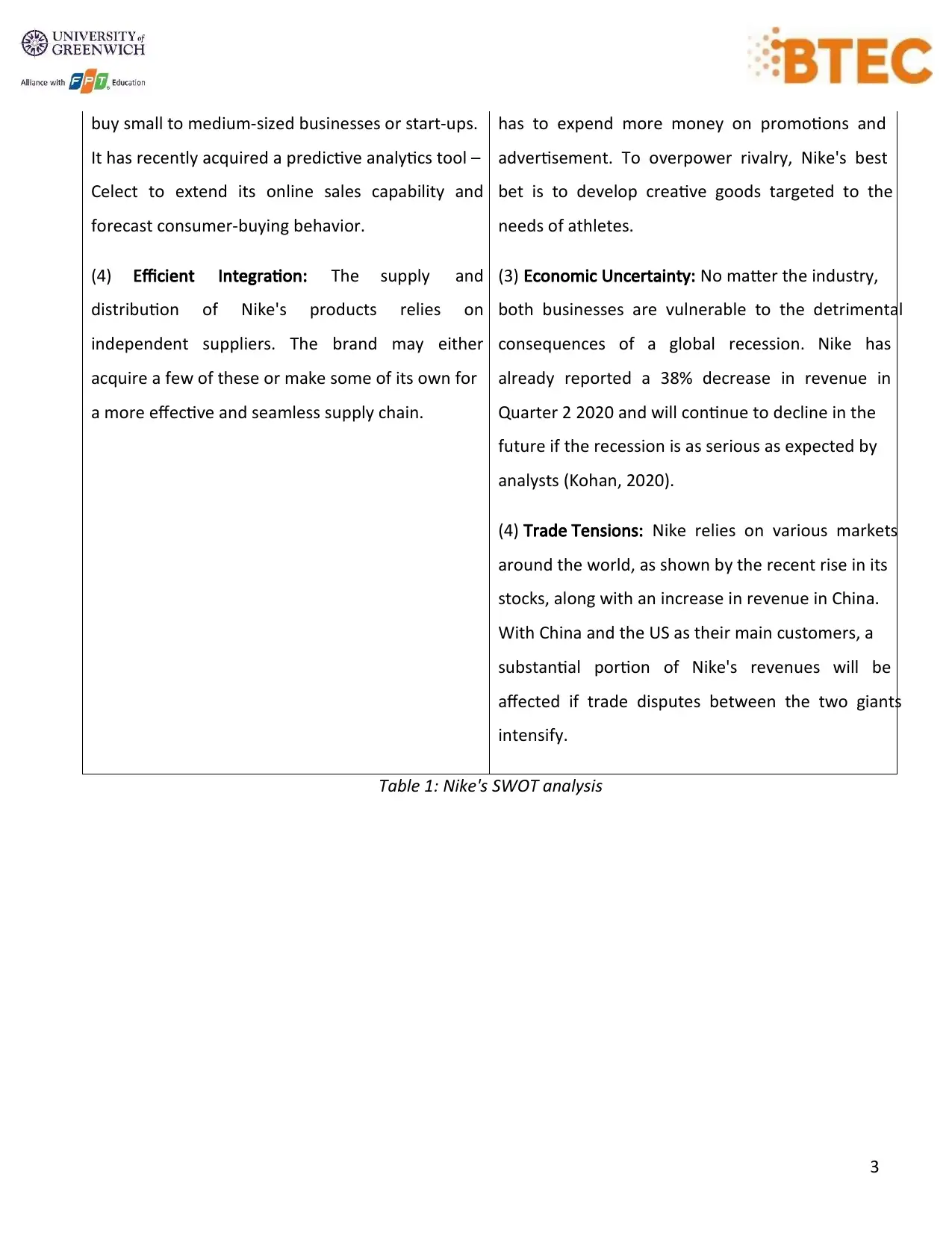
3
buy small to medium-sized businesses or start-ups.
It has recently acquired a predictive analytics tool –
Celect to extend its online sales capability and
forecast consumer-buying behavior.
(4) Efficient Integration: The supply and
distribution of Nike's products relies on
independent suppliers. The brand may either
acquire a few of these or make some of its own for
a more effective and seamless supply chain.
has to expend more money on promotions and
advertisement. To overpower rivalry, Nike's best
bet is to develop creative goods targeted to the
needs of athletes.
(3) Economic Uncertainty: No matter the industry,
both businesses are vulnerable to the detrimental
consequences of a global recession. Nike has
already reported a 38% decrease in revenue in
Quarter 2 2020 and will continue to decline in the
future if the recession is as serious as expected by
analysts (Kohan, 2020).
(4) Trade Tensions: Nike relies on various markets
around the world, as shown by the recent rise in its
stocks, along with an increase in revenue in China.
With China and the US as their main customers, a
substantial portion of Nike's revenues will be
affected if trade disputes between the two giants
intensify.
Table 1: Nike's SWOT analysis
buy small to medium-sized businesses or start-ups.
It has recently acquired a predictive analytics tool –
Celect to extend its online sales capability and
forecast consumer-buying behavior.
(4) Efficient Integration: The supply and
distribution of Nike's products relies on
independent suppliers. The brand may either
acquire a few of these or make some of its own for
a more effective and seamless supply chain.
has to expend more money on promotions and
advertisement. To overpower rivalry, Nike's best
bet is to develop creative goods targeted to the
needs of athletes.
(3) Economic Uncertainty: No matter the industry,
both businesses are vulnerable to the detrimental
consequences of a global recession. Nike has
already reported a 38% decrease in revenue in
Quarter 2 2020 and will continue to decline in the
future if the recession is as serious as expected by
analysts (Kohan, 2020).
(4) Trade Tensions: Nike relies on various markets
around the world, as shown by the recent rise in its
stocks, along with an increase in revenue in China.
With China and the US as their main customers, a
substantial portion of Nike's revenues will be
affected if trade disputes between the two giants
intensify.
Table 1: Nike's SWOT analysis
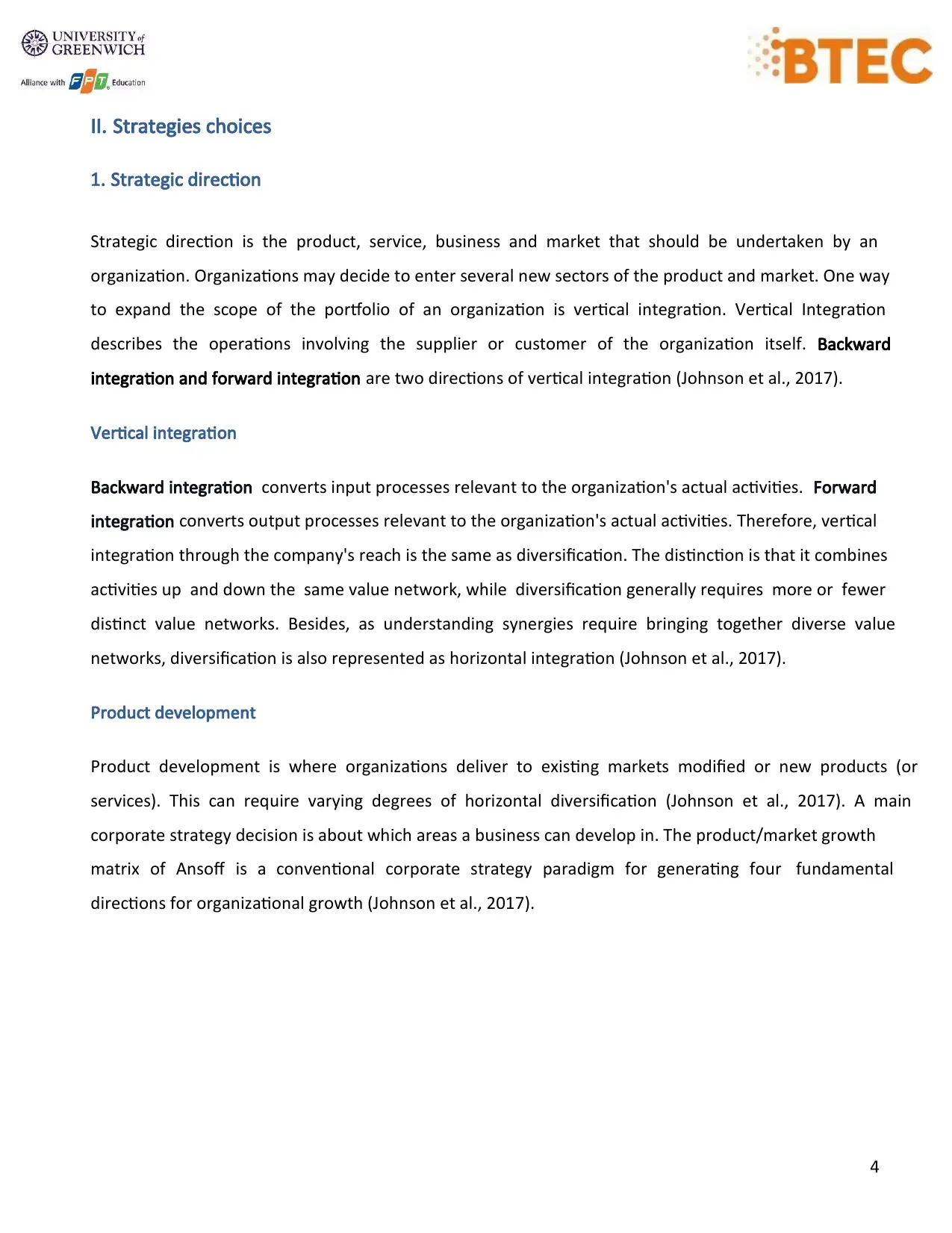
4
II. Strategies choices
1. Strategic direction
Strategic direction is the product, service, business and market that should be undertaken by an
organization. Organizations may decide to enter several new sectors of the product and market. One way
to expand the scope of the portfolio of an organization is vertical integration. Vertical Integration
describes the operations involving the supplier or customer of the organization itself. Backward
integration and forward integration are two directions of vertical integration (Johnson et al., 2017).
Vertical integration
Backward integration converts input processes relevant to the organization's actual activities. Forward
integration converts output processes relevant to the organization's actual activities. Therefore, vertical
integration through the company's reach is the same as diversification. The distinction is that it combines
activities up and down the same value network, while diversification generally requires more or fewer
distinct value networks. Besides, as understanding synergies require bringing together diverse value
networks, diversification is also represented as horizontal integration (Johnson et al., 2017).
Product development
Product development is where organizations deliver to existing markets modified or new products (or
services). This can require varying degrees of horizontal diversification (Johnson et al., 2017). A main
corporate strategy decision is about which areas a business can develop in. The product/market growth
matrix of Ansoff is a conventional corporate strategy paradigm for generating four fundamental
directions for organizational growth (Johnson et al., 2017).
II. Strategies choices
1. Strategic direction
Strategic direction is the product, service, business and market that should be undertaken by an
organization. Organizations may decide to enter several new sectors of the product and market. One way
to expand the scope of the portfolio of an organization is vertical integration. Vertical Integration
describes the operations involving the supplier or customer of the organization itself. Backward
integration and forward integration are two directions of vertical integration (Johnson et al., 2017).
Vertical integration
Backward integration converts input processes relevant to the organization's actual activities. Forward
integration converts output processes relevant to the organization's actual activities. Therefore, vertical
integration through the company's reach is the same as diversification. The distinction is that it combines
activities up and down the same value network, while diversification generally requires more or fewer
distinct value networks. Besides, as understanding synergies require bringing together diverse value
networks, diversification is also represented as horizontal integration (Johnson et al., 2017).
Product development
Product development is where organizations deliver to existing markets modified or new products (or
services). This can require varying degrees of horizontal diversification (Johnson et al., 2017). A main
corporate strategy decision is about which areas a business can develop in. The product/market growth
matrix of Ansoff is a conventional corporate strategy paradigm for generating four fundamental
directions for organizational growth (Johnson et al., 2017).
⊘ This is a preview!⊘
Do you want full access?
Subscribe today to unlock all pages.

Trusted by 1+ million students worldwide
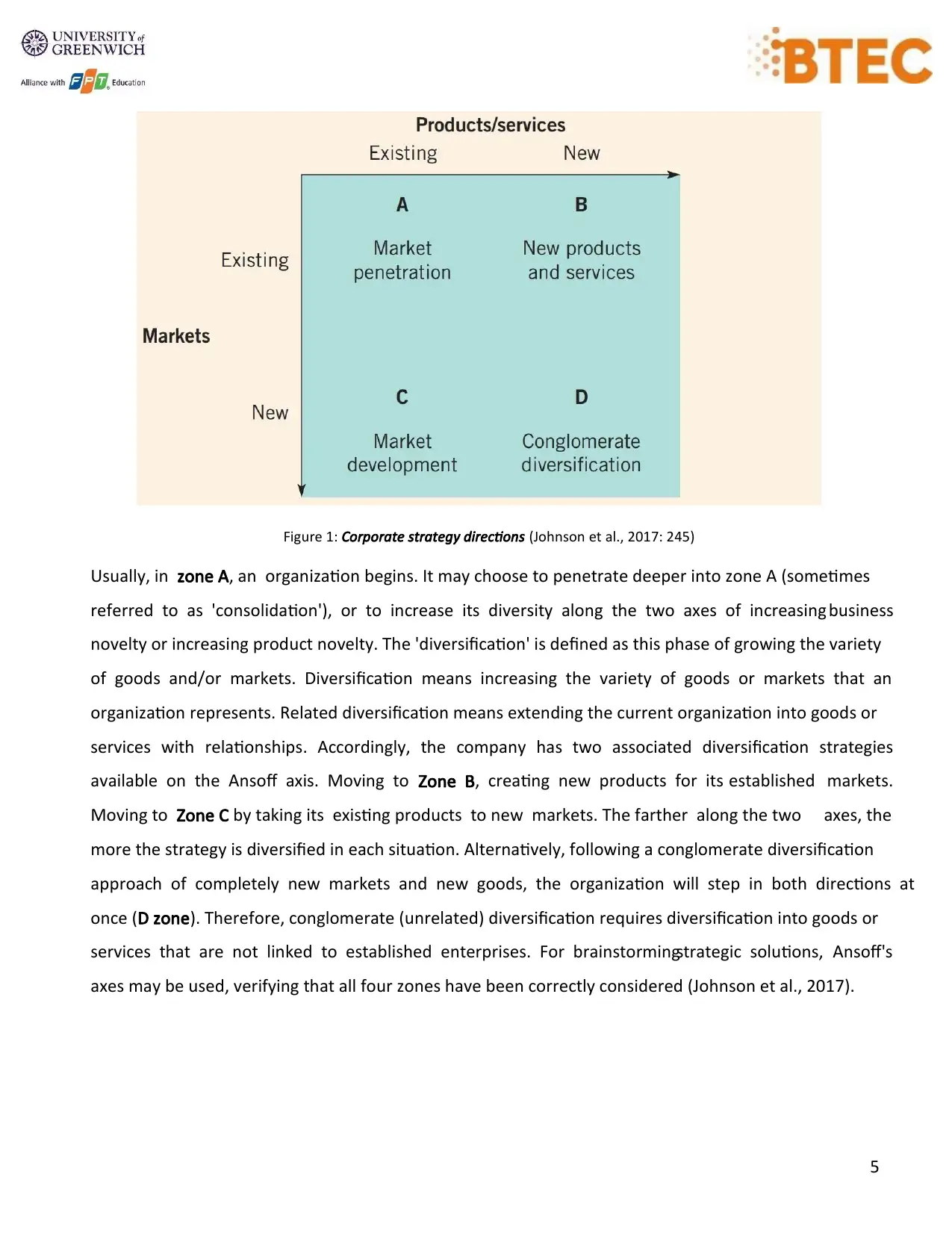
5
Figure 1: Corporate strategy directions (Johnson et al., 2017: 245)
Usually, in zone A, an organization begins. It may choose to penetrate deeper into zone A (sometimes
referred to as 'consolidation'), or to increase its diversity along the two axes of increasing business
novelty or increasing product novelty. The 'diversification' is defined as this phase of growing the variety
of goods and/or markets. Diversification means increasing the variety of goods or markets that an
organization represents. Related diversification means extending the current organization into goods or
services with relationships. Accordingly, the company has two associated diversification strategies
available on the Ansoff axis. Moving to Zone B, creating new products for its established markets.
Moving to Zone C by taking its existing products to new markets. The farther along the two axes, the
more the strategy is diversified in each situation. Alternatively, following a conglomerate diversification
approach of completely new markets and new goods, the organization will step in both directions at
once (D zone). Therefore, conglomerate (unrelated) diversification requires diversification into goods or
services that are not linked to established enterprises. For brainstormingstrategic solutions, Ansoff's
axes may be used, verifying that all four zones have been correctly considered (Johnson et al., 2017).
Figure 1: Corporate strategy directions (Johnson et al., 2017: 245)
Usually, in zone A, an organization begins. It may choose to penetrate deeper into zone A (sometimes
referred to as 'consolidation'), or to increase its diversity along the two axes of increasing business
novelty or increasing product novelty. The 'diversification' is defined as this phase of growing the variety
of goods and/or markets. Diversification means increasing the variety of goods or markets that an
organization represents. Related diversification means extending the current organization into goods or
services with relationships. Accordingly, the company has two associated diversification strategies
available on the Ansoff axis. Moving to Zone B, creating new products for its established markets.
Moving to Zone C by taking its existing products to new markets. The farther along the two axes, the
more the strategy is diversified in each situation. Alternatively, following a conglomerate diversification
approach of completely new markets and new goods, the organization will step in both directions at
once (D zone). Therefore, conglomerate (unrelated) diversification requires diversification into goods or
services that are not linked to established enterprises. For brainstormingstrategic solutions, Ansoff's
axes may be used, verifying that all four zones have been correctly considered (Johnson et al., 2017).
Paraphrase This Document
Need a fresh take? Get an instant paraphrase of this document with our AI Paraphraser
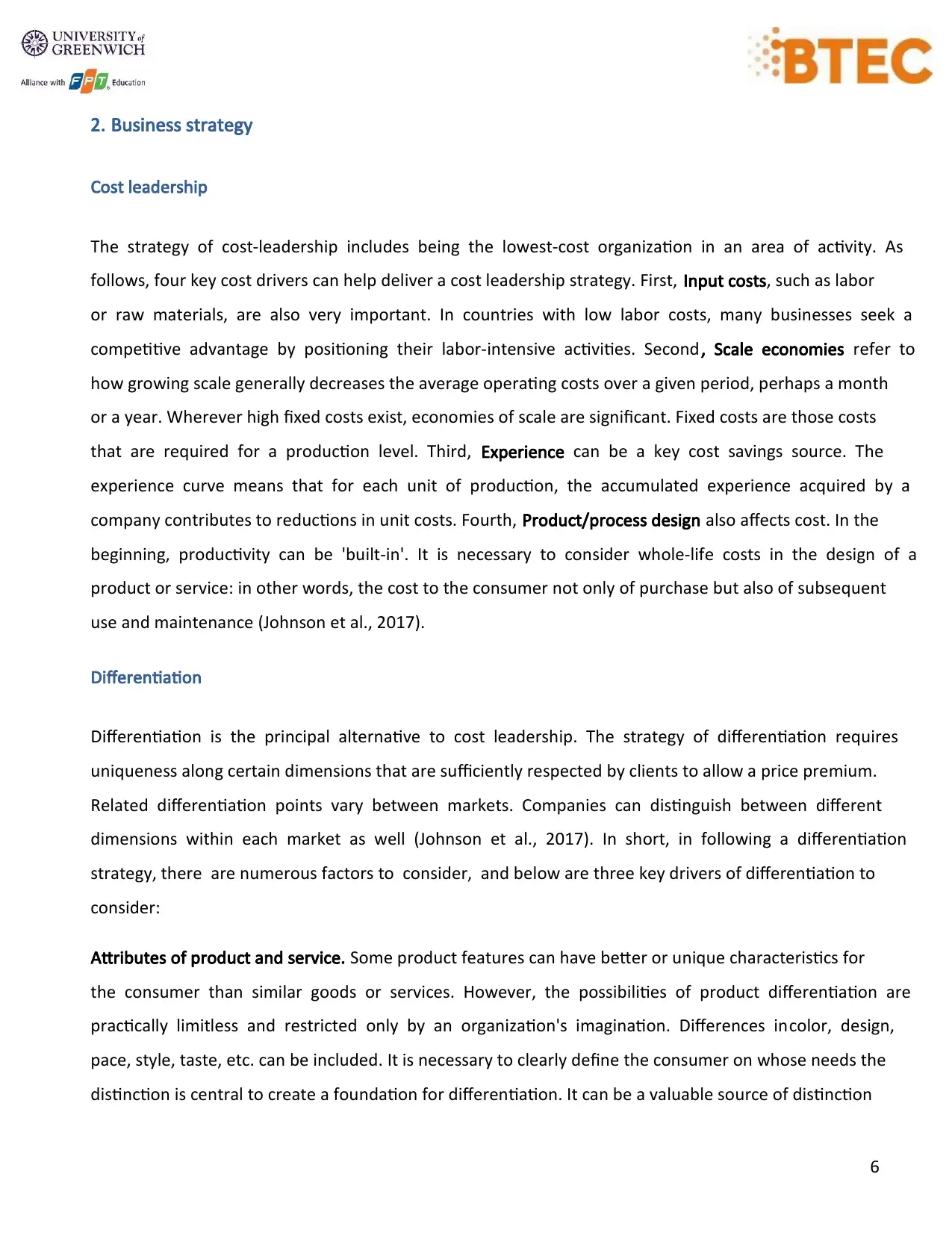
6
2. Business strategy
Cost leadership
The strategy of cost-leadership includes being the lowest-cost organization in an area of activity. As
follows, four key cost drivers can help deliver a cost leadership strategy. First, Input costs, such as labor
or raw materials, are also very important. In countries with low labor costs, many businesses seek a
competitive advantage by positioning their labor-intensive activities. Second, Scale economies refer to
how growing scale generally decreases the average operating costs over a given period, perhaps a month
or a year. Wherever high fixed costs exist, economies of scale are significant. Fixed costs are those costs
that are required for a production level. Third, Experience can be a key cost savings source. The
experience curve means that for each unit of production, the accumulated experience acquired by a
company contributes to reductions in unit costs. Fourth, Product/process design also affects cost. In the
beginning, productivity can be 'built-in'. It is necessary to consider whole-life costs in the design of a
product or service: in other words, the cost to the consumer not only of purchase but also of subsequent
use and maintenance (Johnson et al., 2017).
Differentiation
Differentiation is the principal alternative to cost leadership. The strategy of differentiation requires
uniqueness along certain dimensions that are sufficiently respected by clients to allow a price premium.
Related differentiation points vary between markets. Companies can distinguish between different
dimensions within each market as well (Johnson et al., 2017). In short, in following a differentiation
strategy, there are numerous factors to consider, and below are three key drivers of differentiation to
consider:
Attributes of product and service. Some product features can have better or unique characteristics for
the consumer than similar goods or services. However, the possibilities of product differentiation are
practically limitless and restricted only by an organization's imagination. Differences in color, design,
pace, style, taste, etc. can be included. It is necessary to clearly define the consumer on whose needs the
distinction is central to create a foundation for differentiation. It can be a valuable source of distinction
2. Business strategy
Cost leadership
The strategy of cost-leadership includes being the lowest-cost organization in an area of activity. As
follows, four key cost drivers can help deliver a cost leadership strategy. First, Input costs, such as labor
or raw materials, are also very important. In countries with low labor costs, many businesses seek a
competitive advantage by positioning their labor-intensive activities. Second, Scale economies refer to
how growing scale generally decreases the average operating costs over a given period, perhaps a month
or a year. Wherever high fixed costs exist, economies of scale are significant. Fixed costs are those costs
that are required for a production level. Third, Experience can be a key cost savings source. The
experience curve means that for each unit of production, the accumulated experience acquired by a
company contributes to reductions in unit costs. Fourth, Product/process design also affects cost. In the
beginning, productivity can be 'built-in'. It is necessary to consider whole-life costs in the design of a
product or service: in other words, the cost to the consumer not only of purchase but also of subsequent
use and maintenance (Johnson et al., 2017).
Differentiation
Differentiation is the principal alternative to cost leadership. The strategy of differentiation requires
uniqueness along certain dimensions that are sufficiently respected by clients to allow a price premium.
Related differentiation points vary between markets. Companies can distinguish between different
dimensions within each market as well (Johnson et al., 2017). In short, in following a differentiation
strategy, there are numerous factors to consider, and below are three key drivers of differentiation to
consider:
Attributes of product and service. Some product features can have better or unique characteristics for
the consumer than similar goods or services. However, the possibilities of product differentiation are
practically limitless and restricted only by an organization's imagination. Differences in color, design,
pace, style, taste, etc. can be included. It is necessary to clearly define the consumer on whose needs the
distinction is central to create a foundation for differentiation. It can be a valuable source of distinction
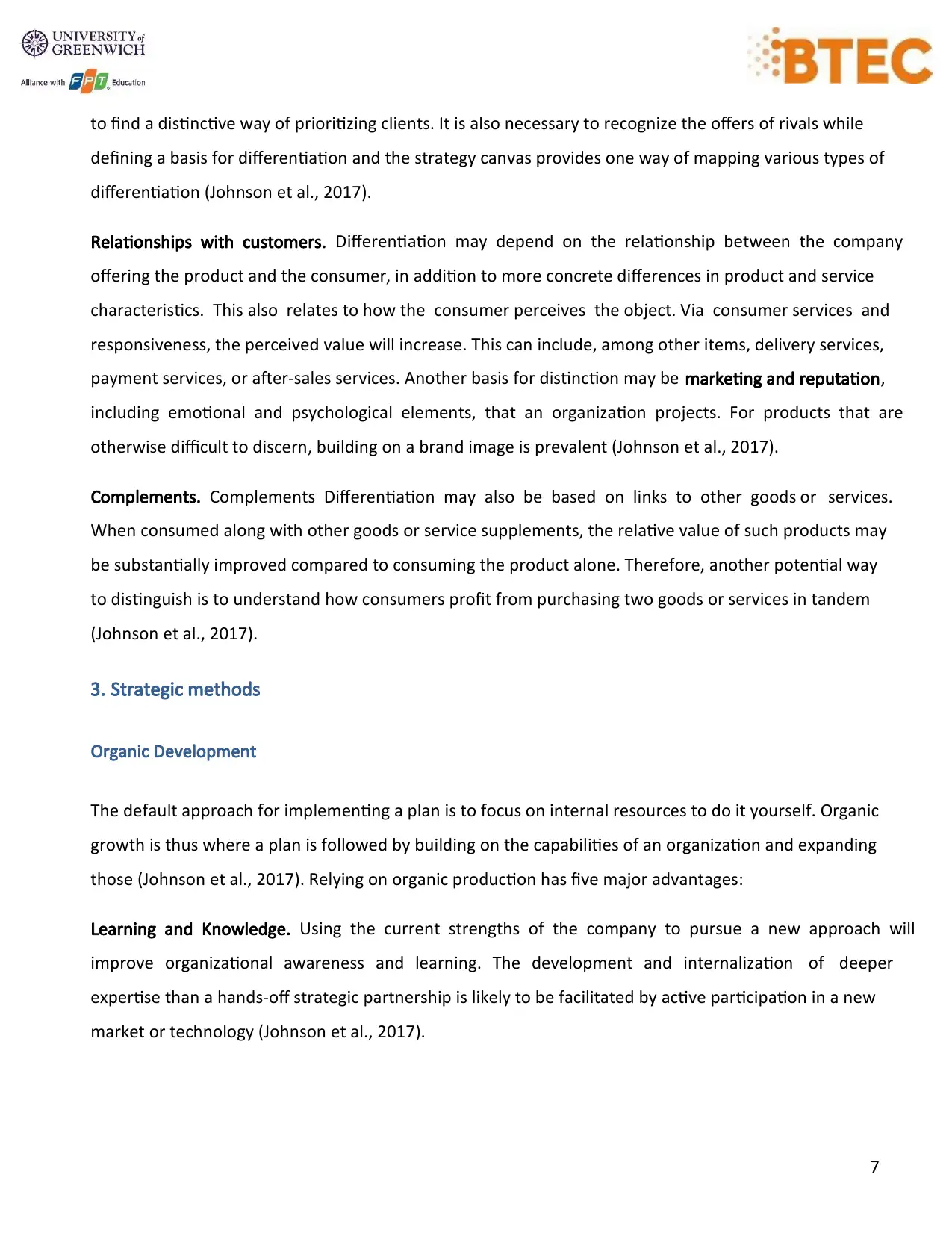
7
to find a distinctive way of prioritizing clients. It is also necessary to recognize the offers of rivals while
defining a basis for differentiation and the strategy canvas provides one way of mapping various types of
differentiation (Johnson et al., 2017).
Relationships with customers. Differentiation may depend on the relationship between the company
offering the product and the consumer, in addition to more concrete differences in product and service
characteristics. This also relates to how the consumer perceives the object. Via consumer services and
responsiveness, the perceived value will increase. This can include, among other items, delivery services,
payment services, or after-sales services. Another basis for distinction may be marketing and reputation,
including emotional and psychological elements, that an organization projects. For products that are
otherwise difficult to discern, building on a brand image is prevalent (Johnson et al., 2017).
Complements. Complements Differentiation may also be based on links to other goods or services.
When consumed along with other goods or service supplements, the relative value of such products may
be substantially improved compared to consuming the product alone. Therefore, another potential way
to distinguish is to understand how consumers profit from purchasing two goods or services in tandem
(Johnson et al., 2017).
3. Strategic methods
Organic Development
The default approach for implementing a plan is to focus on internal resources to do it yourself. Organic
growth is thus where a plan is followed by building on the capabilities of an organization and expanding
those (Johnson et al., 2017). Relying on organic production has five major advantages:
Learning and Knowledge. Using the current strengths of the company to pursue a new approach will
improve organizational awareness and learning. The development and internalization of deeper
expertise than a hands-off strategic partnership is likely to be facilitated by active participation in a new
market or technology (Johnson et al., 2017).
to find a distinctive way of prioritizing clients. It is also necessary to recognize the offers of rivals while
defining a basis for differentiation and the strategy canvas provides one way of mapping various types of
differentiation (Johnson et al., 2017).
Relationships with customers. Differentiation may depend on the relationship between the company
offering the product and the consumer, in addition to more concrete differences in product and service
characteristics. This also relates to how the consumer perceives the object. Via consumer services and
responsiveness, the perceived value will increase. This can include, among other items, delivery services,
payment services, or after-sales services. Another basis for distinction may be marketing and reputation,
including emotional and psychological elements, that an organization projects. For products that are
otherwise difficult to discern, building on a brand image is prevalent (Johnson et al., 2017).
Complements. Complements Differentiation may also be based on links to other goods or services.
When consumed along with other goods or service supplements, the relative value of such products may
be substantially improved compared to consuming the product alone. Therefore, another potential way
to distinguish is to understand how consumers profit from purchasing two goods or services in tandem
(Johnson et al., 2017).
3. Strategic methods
Organic Development
The default approach for implementing a plan is to focus on internal resources to do it yourself. Organic
growth is thus where a plan is followed by building on the capabilities of an organization and expanding
those (Johnson et al., 2017). Relying on organic production has five major advantages:
Learning and Knowledge. Using the current strengths of the company to pursue a new approach will
improve organizational awareness and learning. The development and internalization of deeper
expertise than a hands-off strategic partnership is likely to be facilitated by active participation in a new
market or technology (Johnson et al., 2017).
⊘ This is a preview!⊘
Do you want full access?
Subscribe today to unlock all pages.

Trusted by 1+ million students worldwide
1 out of 21
Related Documents
Your All-in-One AI-Powered Toolkit for Academic Success.
+13062052269
info@desklib.com
Available 24*7 on WhatsApp / Email
![[object Object]](/_next/static/media/star-bottom.7253800d.svg)
Unlock your academic potential
Copyright © 2020–2025 A2Z Services. All Rights Reserved. Developed and managed by ZUCOL.





